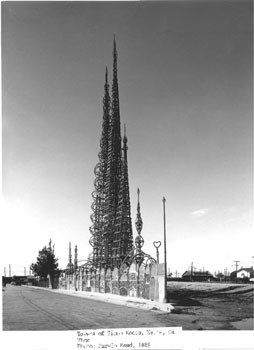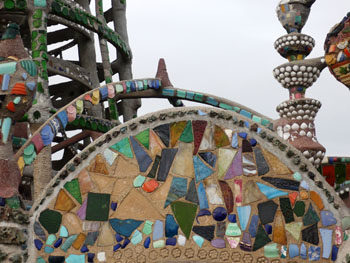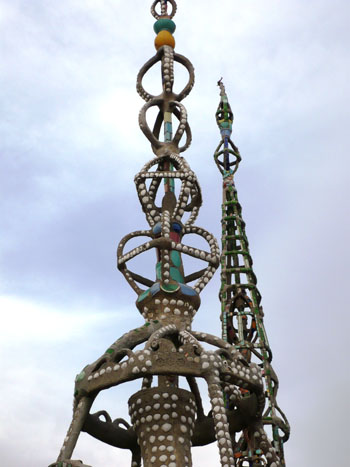
I write about bridging the cultural divide in our cities -- but it took a well-heeled art consultant who invited me to trail along with a busload of her similarly endowed clients and friends to get me to the Watts Towers, even though I have lived in Los Angeles for more than two decades. I tried to think about why this was since I pride myself on seeking out culture wherever it is, and especially if it is off the beaten path.
The chasm that separates those of us with resources to ingest the goodies the world has to offer us and those, like my inner city high school mentees who live a block away from Disney Hall but who have never been able to walk inside, is the result of the literal freeway that divides the West from East, and thus rich from poor, in LA. If it's not in our own backyards, and especially if it's in storied Watts, scene of the 1965 riots, visits tend to be postponed. Many of the women on this bus tour freely admitted to being strangers to downtown LA where quite a few of our major cultural venues dominate; Watts then, was certainly beyond the divide as we munched our honey muffins (way there) and veggie wraps (way back). last Friday on our expedition.
The Watts of 2008 is not the same as the one Simon Rodia could overlook dangling from his window washer's rigging adjacent to a major rail line. A solitude-seeking Italian immigrant daylaborer (a man who bought soap at a local store before he boarded the bus just so he could avoid the pain of articulating his request for change), Rodia constructed the seventeen interconnected structures over a period of 33 years from 1921 to 1954 at night, after a long day at other menial labor. An outsider who reportedly played Caruso at home, he had an artistic soul yearning to breathe free and turns out to have been an early precursor of Olafur Eliasson and Matthew Barney and Francis Alys, all of whom digest their environments on our behalf, often making large the fantasies and fears that reside deep in most of us.
Perhaps it augured, then reflected the Depression, his save-everything mentality -- bits of glass and pop bottles and teapots, souvenir kitsch, railroad scrap and Malibu tile (see the Adamson House in Malibu, home of the family that owned the tileworks for the upscale version), but the thing that is striking when you first arrive at the towers is this: they are not so much tall (the tallest, almost a hundred feet) as they are like an elegant, filigreed forest. Rodia planted this cement garden and imaginary boat all around his bungalow which subsequently burned down after he had fled an unhospitable Los Angeles. But the foundation is still there with its fireplace, and one can easily imagine him with a bottle of something to warm him (he was a legendary drinker), listening to Caruso, gazing with joy out the window on his tiled, green-and blue-glassed minaret-ed wonderland.

The other thing that is striking, beyond the glitter and glory of the ingeniousness of his port and starboard, Dale Chihuly-like canopied construction, is the quiet suburban neighborhood that has grown up around it. Only the fences that now surround each house and the towers (and the pit bull puppy running wild and sniffing in yesterday's garbage) bespeak the 00's: the houses are clean, well-kempt, adorned with religious statuary (at one point in the tour, I distinctly heard a rooster crowing). Busloads of tourists (the site is apparently among the most visited by foreign tourists, if not our native Angelenos) do not seem to faze the residents and a new Charles Mingus community center nearing completion (Mingus also lived nearby) supplements the already low-rise neighborhood center that not only screens a marvelous early documentary about Rodia but caters to children, school groups and adults as well. An enthusiastic bunch of third graders who are part of a Transit Program that gets inner city kids out to activities by rail were there when we were--hooray, public transportation and tax dollars are working sometimes in LA!
Like the rest of LA, Watts has become home to the bourgening Latino population, which doesn't always coexist with the more vested African American residents, yet here, around the center, town, gown and alums all seem to be in a harmonious mix. The center's director, Rosie Lee Hooks, is at pains to welcome our busload of impeccably turned out ladies realizing the fund raising potential (wives of boldface names studded the tony group), reminding us that today's Watts has "loving, caring families" and is no longer the Watts of our riot-dated imaginations.
A local free paper, the LA Watts Times on offer at the center tells a little more of that tale, an upward-bound mentality that resonates. Last Thursday's headlines were "Does Obama's Iowa win show US is colorblind in Presidential Race?" and "Study: Whites in the US are More Likely than Minorities to Get Narcotics from ER Doctors" and "Golfing Program Puts More Black Women on the Course."
They're right to flag progress, especially with all the chatter about LA's Latino population superceding the African American core that was long a powerful minority constituency but is now struggling to maintain a foothold in Los Angeles politics. Some in the know on the bus (zoo commissioners, music center divas) said they had heard that the center's funding had been cut back or entirely eliminated. This seems not to be the case, especially with the new youth center going up next door....let's hope the funds stay in place. On this Martin Luther King Jr. weekend, it would be a perfect place to visit, a site where people are actually coming together to make a difference.
At one point, our exuberant tour guide who finished her tour with an ode she had written to the towers, urged us to hold on to the thin, but sturdy lower railing of one of the towers, bend backwards and look up. It is a heady, uplifting place and one's spirit soars at the inarguable logic of Rodia whose heroes were Galileo, Michelangelo and Columbus, a dreamer, but also a doer, someone who was able to sift and sort debris and make it come out as art, his way.
It's a lesson we can all take from this bricoleur-par-excellence: right around all of us are jewels -- friends, family, objects -- which need only to be placed just so with loving tenderness to make them sparkle and shine for us in entirely new dimensions. This is the virtual freeway which threatens to divides us, one which exists only in our minds.

Rodia had two Mexican wives; Italian was his native language -- in another prescient inclusive gesture -- he named his creation, Nuestro Pueblo or Our Town. Though he suffered community approbation, numerous layoffs and years of backbreaking labor (with his fedora on) to build his Pisa-esque towers, he fulfilled his dream, saying: "I had in mind to do something big and I did it."
How about that for a New Year's res?